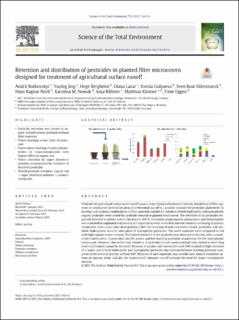| dc.contributor.author | Butkovskyi, Andrii | |
| dc.contributor.author | Jing, Yuying | |
| dc.contributor.author | Bergheim, Hege | |
| dc.contributor.author | Lazar, Diana | |
| dc.contributor.author | Gulyaeva, Ksenia | |
| dc.contributor.author | Odenmarck, Sven R. | |
| dc.contributor.author | Norli, Hans Ragnar | |
| dc.contributor.author | Nowak, Karolina M. | |
| dc.contributor.author | Miltner, Anja | |
| dc.contributor.author | Kästner, Matthias | |
| dc.contributor.author | Eggen, Trine | |
| dc.date.accessioned | 2022-03-04T10:51:54Z | |
| dc.date.available | 2022-03-04T10:51:54Z | |
| dc.date.created | 2022-02-15T15:15:02Z | |
| dc.date.issued | 2021-03-15 | |
| dc.identifier.citation | Science of the Total Environment. 2021, 778 . | en_US |
| dc.identifier.issn | 0048-9697 | |
| dc.identifier.uri | https://hdl.handle.net/11250/2983097 | |
| dc.description.abstract | Pesticides in agricultural surface water runoff cause a major threat to freshwater systems. Installation of filter systems or constructed wetlands in areas of preferential run-off is a possible measure for pesticides abatement. To develop such systems, combinations of filter materials suitable for retention of both hydrophilic and hydrophobic organic pesticides were tested for pesticide removal in planted microcosms. The retention of six pesticides frequently detected in surface waters (bentazone, MCPA, metalaxyl, propiconazole, pencycuron, and imidacloprid) was evaluated in unplanted and planted pot experiments with novel bed material mixtures consisting of pumice, vermiculite, water super-absorbent polymer (SAP) for retention of ionic and water soluble pesticides, and synthetic hydrophobic wool for adsorption of hydrophobic pesticides. The novel materials were compared to soil with high organic matter content. The highest retention of the pesticides was observed in the soil, with a considerable translocation of pesticides into the plants, and low leaching potential, in particular for the hydrophobic compounds. However, due to the high retention of pesticides in soil, environmental risks related to their long term mobilization cannot be excluded. Mixtures of pumice and vermiculite with SAP resulted in high retention of i) water and ii) both hydrophilic and hydrophobic pesticides but with much lower leaching potential compared to the mineral systems without SAP. Mixtures of such materials may provide near natural treatment options in riparian strips and also for treatment of rainwater runoff without the need for water containment systems. | en_US |
| dc.language.iso | eng | en_US |
| dc.publisher | Elsevier B.V. | en_US |
| dc.rights | Attribution-NonCommercial-NoDerivatives 4.0 Internasjonal | * |
| dc.rights.uri | http://creativecommons.org/licenses/by-nc-nd/4.0/deed.no | * |
| dc.title | Retention and distribution of pesticides in planted filter microcosms designed for treatment of agricultural surface runoff | en_US |
| dc.type | Peer reviewed | en_US |
| dc.type | Journal article | en_US |
| dc.description.version | publishedVersion | en_US |
| dc.rights.holder | © 2021 The Authors | en_US |
| dc.source.pagenumber | 9 | en_US |
| dc.source.volume | 778 | en_US |
| dc.source.journal | Science of the Total Environment | en_US |
| dc.identifier.doi | 10.1016/j.scitotenv.2021.146114 | |
| dc.identifier.cristin | 2001900 | |
| dc.relation.project | EC/H2020/689271 | en_US |
| dc.relation.project | Norges forskningsråd: 272309 | en_US |
| dc.source.articlenumber | 146114 | en_US |
| cristin.ispublished | true | |
| cristin.fulltext | original | |
| cristin.qualitycode | 2 | |

